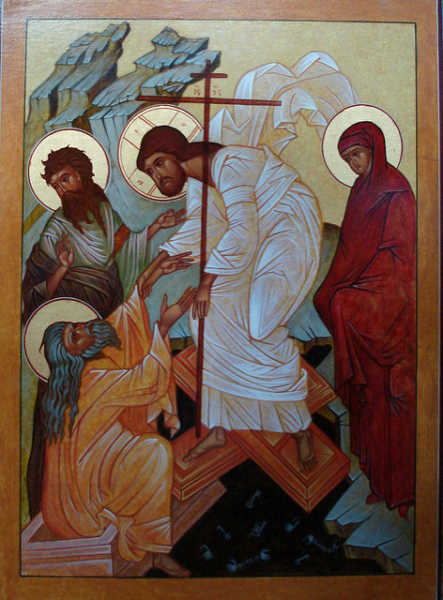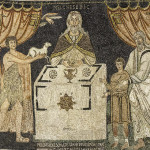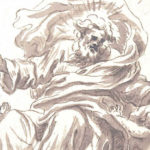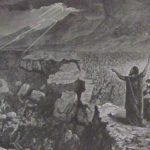We run our website the way we wished the whole internet worked: we provide high quality original content with no ads. We are funded solely by your direct support. Please consider supporting this project.

The God Who Stoops
The way that one imagines God can be thought of along the lines of a Rorschach test. That is, I submit that the way a person imagines and experiences God says at least as much about that person as it does God. The more estranged people are from God, the more their knowledge of him is obstructed and distorted. And when people yield to the Spirit, they are empowered to discern the true glory of God “in the face of Jesus Christ.”
That being said, the standard that must function as the ultimate criteria by which we assess the extent to which any conception and experience of God is accurate or inaccurate is the revelation of God in the crucified Christ.
Hence, on the one hand, to the extent that any conception and experience of God conforms to the character of God revealed on the cross, we may conclude that the Spirit has managed to break through the limited and fallen hearts and minds of people. On the other hand, to the extent that any conception or experience fails to conform to this character, we must conclude that the limited and fallen hearts and minds of people have resisted the Spirit.
Given Scripture’s repeated teaching that the people God claimed for himself in the OT were a “stiff-necked” people who continually resisted the Spirit, we ought not be surprised to discover that their conceptions and experiences of God were sometimes distorted. To the contrary, I believe we ought to rather be impressed by how frequently the Spirit succeeded in breaking through to disclose beautiful portraits of God that reflect his true character.
Knowing what we now know about God through his self-revelation on Calvary, we ought to be able to discern the true character of God in the depths of even the most seriously distorted portraits of God in the OT. For when we view them through the lens of the cross, we can see that there is something going on beneath the surface. We can discern in their depth the same humble God of self-sacrificial love stooping to bear the sin of his people that we discern on the cross.
In the OT, we can see God working within his people’s faulty Rorschach-like conceptions and experiences of him. God was bearing the sinful perspectives of his covenant people, including the horrifically violent concepts they had of him. He was accommodating the hard-heartedness of his people, stooping to their level to move his people in the right direction. The fact that God was willing to stoop in this fashion and bear the sin of his people reveals God’s true character, anticipating the revelation of God ultimately revealed on the cross.
Photo credit: jimforest via Visualhunt.com / CC BY-NC-ND
Category: General
Tags: Bible Interpretation, Cruciform Theology
Topics: Interpreting Violent Pictures and Troubling Behaviors
Related Reading

What’s the Purpose of the Old Testament Law?
Whereas the old covenant was rooted in the law, the new covenant is rooted in simple faith, such as Abraham had. Whereas the old covenant was forged with one particular nation, the new covenant is available to all who are willing to accept it, regardless of their ethnicity and nationality. Whereas forgiveness of sins within…

Podcast: Isn’t God Withdrawing the SAME as Him Personally Punishing and Causing Violence?
Greg discusses whether the passivity of withdrawal is distinguishable from active punishment. http://traffic.libsyn.com/askgregboyd/Episode_0186.mp3

One Hope
When Jesus was crucified by his enemies instead of conquering his enemies, the hope of Jesus’ disciples came crashing down in utter despair. They had hoped that Jesus would establish the kingdom of God in the same way that other kingdoms were established. However, the resurrection reveals that the kingdom of God is not like…

Four Principles of the Cruciform Thesis
In the second volume of Crucifixion of the Warrior God, I introduce how four dimensions of the revelation of God on the cross (as introduced in this post) lead to four principles that show us how to unlock aspects of the OT’s violent divine portraits and thus disclose how a given portrait bears witness to…

Overview of Crucifixion of the Warrior God
Greg reviewed the content of his new book, Crucifixion of the Warrior God, as a part of the Woodland Hills Church Covenant Partner gathering on March 5, 2017. If you want a fairly succinct synopsis of the thesis of his book, look no further. Ten years ago, Greg set out to write a book justifying the…

Classical Theism’s Unnecessary Paradoxes
The traditional view of God that is embraced by most—what is called “classical theology”—works from the assumption that God’s essential divine nature is atemporal, immutable, and impassible. The Church Fathers fought to articulate and defend the absolute distinction between the Creator and creation and they did this—in a variety of ways—by defining God’s eternal nature…
